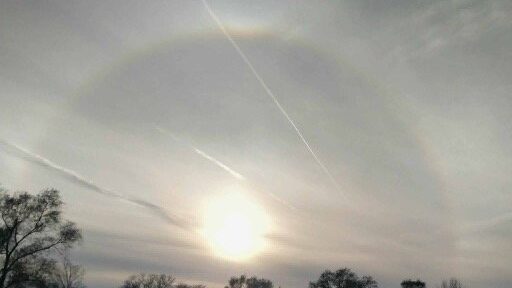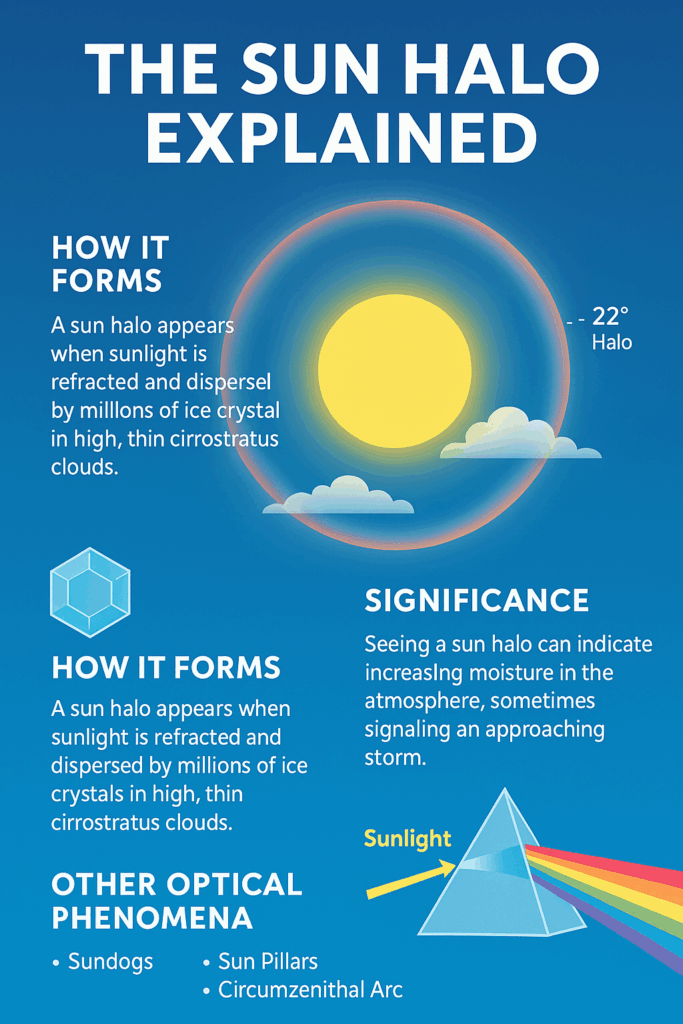Sun Halos: What They Are, How They Form, and What They Mean

If you’ve ever looked up and noticed a glowing, colorful ring around the Sun, you’ve seen a sun halo—often called a “rainbow around the sun.” These striking circles are more than just eye-candy; they’re clues about what’s happening high in the atmosphere.
What is a sun halo?
Most sun halos are 22-degree halos: a bright, whitish ring with a subtle red inner edge and bluish outer edge centered on the Sun. The ring’s radius—about an outstretched hand plus a thumb from the Sun—is set by physics, so it’s the same size anywhere on Earth.

How do sun halos form?
Sun halos form when sunlight passes through millions of tiny hexagonal ice crystals suspended in high, thin clouds (usually cirrostratus) 5–13 km (3–8 miles) above the ground. As light refracts (bends) and disperses inside those crystals, certain angles are favored—especially ~22°. The collective result is a circular ring.
Key points:
- Ice crystals: hexagonal plates or columns act like miniature prisms.
- Refraction + dispersion: different wavelengths bend differently, creating faint color separation (red inside, blue outside).
- Orientation: randomly oriented crystals give a full ring; aligned crystals create arcs, pillars, and other shapes.
Are sun halos dangerous?
The halo itself isn’t dangerous—it’s just light. The Sun can be: never stare at the Sun with unprotected eyes, and use caution when photographing (use your hand, a building, or a brim to block the solar disk). For cameras, avoid aiming directly at the Sun for long periods; use live view and lens hoods.
What do sun halos signify for the weather?
Cirrostratus clouds that produce halos often appear ahead of a warm front or an approaching storm system. Seeing a halo can mean moisture is increasing aloft, sometimes signaling precipitation within 12–36 hours—not a guarantee, but a classic weather lore hint that the pattern is changing.
When are sun halos most common?
While sun halos can appear at any time of year as long as high, ice-crystal clouds are present, certain conditions make them more likely. They tend to be more frequent during the colder seasons in mid-latitudes, when upper-level ice clouds are abundant and jet-stream dynamics are strong. Halos also commonly appear ahead of large-scale weather systems throughout the year, since cirrostratus cloud shields often form before widespread rain or snow. In addition, halos and related optical displays are generally more common in polar and high-altitude regions, where cold, ice-filled clouds are a regular feature of the atmosphere.
Other ice-crystal optical phenomena (besides halos)
Atmospheric ice crystals can create an entire gallery of displays. Watch for:
- Sundogs (parhelia): Bright “mock suns” flanking the Sun at the same elevation, typically on either side of the 22° halo—most vivid when it’s very cold with plate-like crystals.
- Sun pillars: A vertical shaft of light above (or below) the Sun near sunrise/sunset, caused by reflection off plate crystals.
- Circumzenithal arc (CZA): A vivid, upside-down “smile” high in the sky—often the most colorful ice-crystal display.
- Circumhorizontal arc (CHA): A long, rainbow-like band low in the sky, sometimes nicknamed a “fire rainbow” (not a real rainbow). Requires the Sun high in the sky and plate crystals.
- Upper/lower tangent arcs: Wing-like arcs that touch the 22° halo at its top or bottom, changing shape as the Sun’s elevation changes.
- 46-degree halo: A larger, fainter ring farther from the Sun.
- Parhelic circle: A horizontal white circle through the Sun that can host sundogs and other bright spots.
How to spot and photograph a sun halo
- Timing: Look when you see a thin, milky veil of high cloud—especially ahead of a front.
- Safety: Block the Sun with a building, tree, or your hand to reduce glare.
- Composition: Ultra-wide lenses capture the full ring; include foreground (trees, skyline) for scale.
- Exposure: Underexpose slightly to preserve the ring’s color; shoot RAW for better post-processing.
Quick FAQ
Is a sun halo the same as a rainbow?
No. Rainbows form from raindrops with internal reflection; sun halos form from ice crystals via refraction/dispersion (and sometimes reflection), usually in high clouds.
Can I see a halo around the Moon?
Yes—a moon halo is the same optics at night, often signaling incoming high-level moisture.
Does a halo guarantee rain or snow?
Not guaranteed, but it often precedes unsettled weather within a day or so.
–Story Image: Diane Ebert